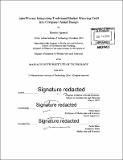| dc.contributor.advisor | Pattie Maes. | en_US |
| dc.contributor.author | Agrawal, Harshit, S.M. Massachusetts Institute of Technology | en_US |
| dc.contributor.other | Program in Media Arts and Sciences (Massachusetts Institute of Technology) | en_US |
| dc.date.accessioned | 2016-12-22T16:27:25Z | |
| dc.date.available | 2016-12-22T16:27:25Z | |
| dc.date.copyright | 2016 | en_US |
| dc.date.issued | 2016 | en_US |
| dc.identifier.uri | http://hdl.handle.net/1721.1/106063 | |
| dc.description | Thesis: S.M., Massachusetts Institute of Technology, School of Architecture and Planning, Program in Media Arts and Sciences, 2016. | en_US |
| dc.description | Cataloged from PDF version of thesis. | en_US |
| dc.description | Includes bibliographical references (pages 83-87). | en_US |
| dc.description.abstract | The need and desire to create objects is built into human civilization throughout history. The immense diversity of cultures in the world has led to the development of tremendously diverse design and making traditions. Each of these reflects unique imagination threads in our collective thought process and carries immense value in the growth of it. These days, we are witnessing a rise in the digital maker movement, propelled by digital fabrication machines like 3D printers. These are democratizing manufacturing, however, a point to note is that all of the CAD (computer aided design) software tools to design objects for digital fabrication have been developed in an industrial context. This inherently means that these tools support operations like extrude, revolve etc., but not traditional operations like weaving techniques (plaiting, twining etc.) for example. Digital design language therefore lacks a representation of the diverse making traditions and as such these are not accessible to people to design with. This projects to a subsequent decline in usage of these traditional methods resulting in them slowly fading out. Instead, modem design tools should celebrate the diversity of making traditions and harness the strength of digital means combining it with traditional operations and aesthetics to create objects that were not possible with either of them individually. Through this thesis, I explore questions around how traditional making practices can be incorporated in CAD tools. How can one approach the design of such a tool and what is the variety of design possibilities this opens up, once the traditional and modern techniques inter-weave. I present InterWoven, a CAD tool that aids people in creating designs using traditional basket-weaving techniques. | en_US |
| dc.description.statementofresponsibility | by Harshit Agrawal. | en_US |
| dc.format.extent | 87 pages | en_US |
| dc.language.iso | eng | en_US |
| dc.publisher | Massachusetts Institute of Technology | en_US |
| dc.rights | M.I.T. theses are protected by copyright. They may be viewed from this source for any purpose, but reproduction or distribution in any format is prohibited without written permission. See provided URL for inquiries about permission. | en_US |
| dc.rights.uri | http://dspace.mit.edu/handle/1721.1/7582 | en_US |
| dc.subject | Program in Media Arts and Sciences () | en_US |
| dc.title | InterWoven : integrating traditional basket weaving craft into computer aided design | en_US |
| dc.title.alternative | Inter Woven : integrating traditional basket weaving craft into computer aided design | en_US |
| dc.title.alternative | Integrating traditional basket weaving craft into CAD | en_US |
| dc.type | Thesis | en_US |
| dc.description.degree | S.M. | en_US |
| dc.contributor.department | Program in Media Arts and Sciences (Massachusetts Institute of Technology) | en_US |
| dc.identifier.oclc | 964933614 | en_US |
